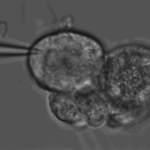Translational Update Pain
Does rodent pain expression pattern translate to human? Dorsal root ganglia (DRGs) control nociceptive input from the periphery to the brain as they contain the cell bodies of primary afferent neurons. DRG expression patterns have been analyzed for many years and expression changes have been described for various chronic pain conditions in rodent DRGs.
Researchers from the University of Texas at Dallas now took another step in resolving the situation in human. Human DRGs are available for research purposes thanks to organ donors. Native human DRGs probably represent the cell type by which one can get as close as possible to the human pain transmitting system in vitro. In their previous work, they compared mouse and human DRG transcriptomes generated by RNA sequencing (PMID 29561359) and quantified differences between mouse and human DRGs by means of in situ hybridization (PMID 32639368). Now, they refined the molecular fingerprints of DRGs by spatial transcriptomics assessment (https://doi.org/10.1101/2021.02.06.430065). Based on DRGs from eight donors they were able to identify ten different clusters of human nociceptors including C-nociceptors, Aδ-nociceptors as well as Aδ and Aβ subtypes. The assessment revealed differences between human, rodent, and non-human primates as well as differences between the pattern of female and male organ donors. Unraveling the spatial genetic profile of DRGs is an important step from the clinics towards back-translation into pre-clinical work. It can give guidance on the differentiation paradigms of human inducible pluripotent stem cells (iPSCs), which are available in much larger scale than human DRGs and can be readily studied using functional readouts such as Ca++ imaging or electrophysiology.
Conclusion
Thus, the recent spatial transcriptome fingerprint of human DRGs represents an important piece of the puzzle of translational pain research and contributes to our understanding of human pain regulation.It now needs to be integrated in our thinking of drug discovery and drug development to speed up the identification of novel targets for innovative analgesic drugs for chronic pain conditions with high unmet medical need. Furthermore, this data strengthens the 3R’s approach in a CNS indication which heavily depends on neuronal circuits and feedback loops.

© Thomas Christoph
